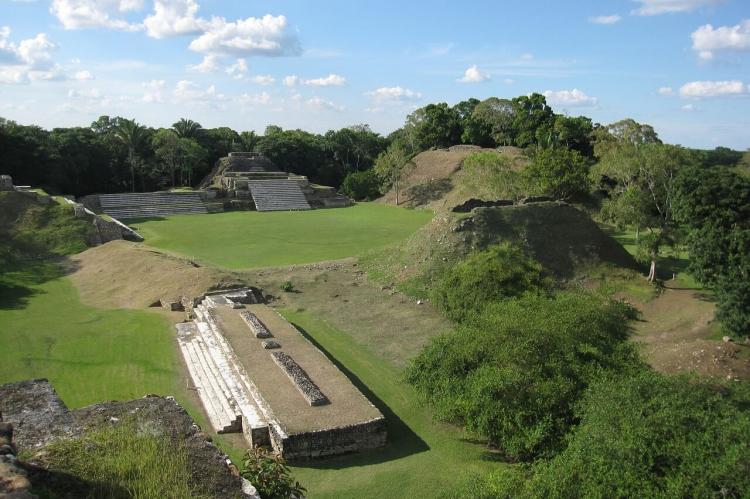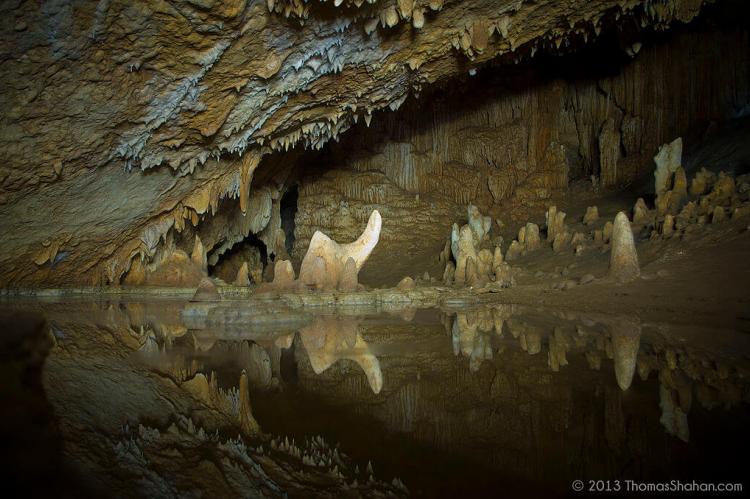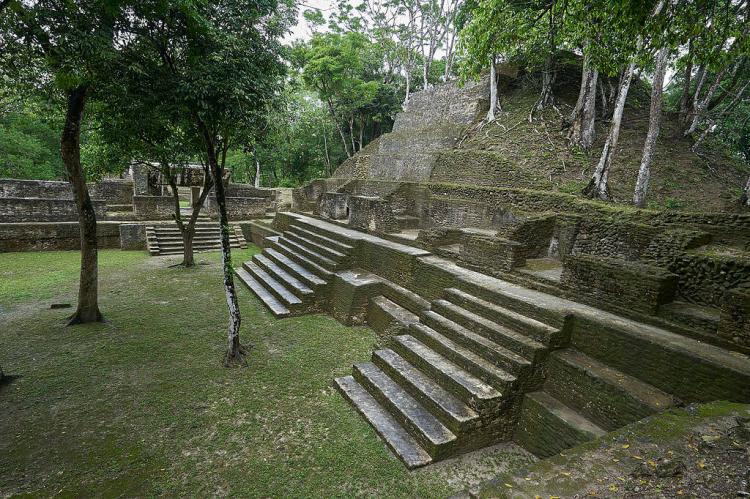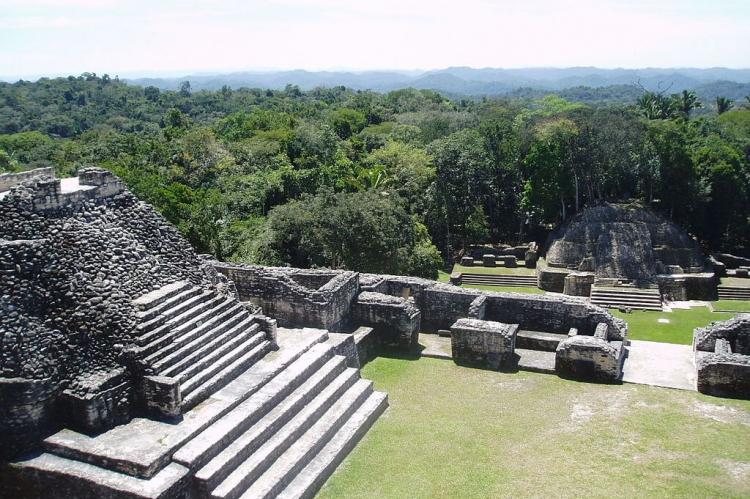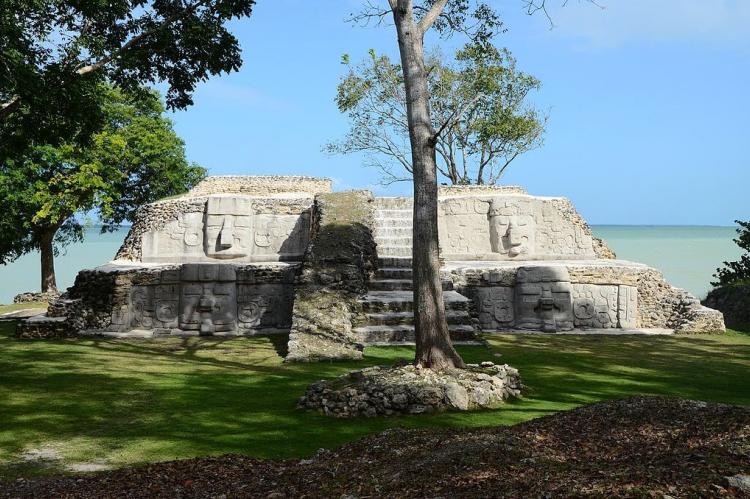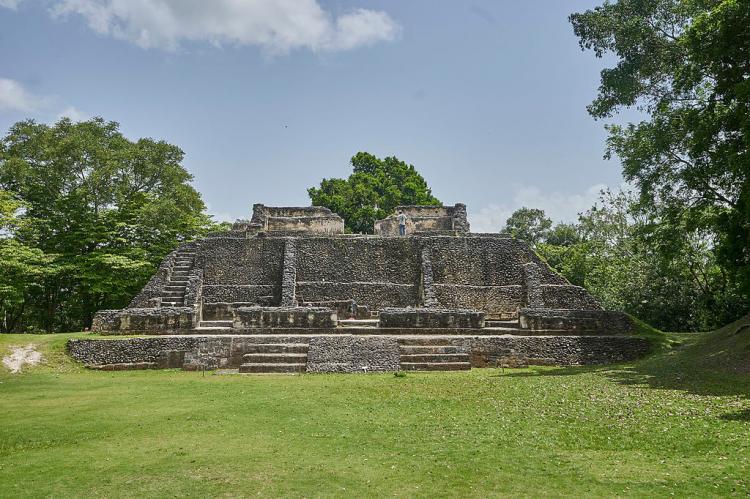Belize: Pre-Columbian Maya Ruins and Archaeological Sites
Some well-known and historically significant pre-Columbian Maya archaeological sites are found in Belize, considered part of the southern Maya lowlands of the Mesoamerican culture area. The sites found here were occupied until the arrival of the Spanish.
Pre-Columbian Maya Ruins and Archaeological Sites in Belize
Some well-known and historically significant pre-Columbian Maya archaeological sites are found in Belize, considered part of the southern Maya lowlands of the Mesoamerican culture area. The sites found here were occupied from the Preclassic period (2000 BCE - 200 CE) until and after the arrival of the Spanish in the 16th century.
Actun Tunichil Muknal
Actun Tunichil Muknal (ATM), or (Cave of the Crystal Sepulchre) is a cave in Belize, near San Ignacio, Cayo District, in an area known as the Mountain Tapir Reserve. The ATM cave is notable as a Maya archaeological site that includes skeletons, ceramics, and stoneware.
There are several areas with skeletal remains in the main chamber. The best known is "The Crystal Maiden," the skeleton of an adolescent (an 18-year-old girl), possibly a sacrifice victim, whose bones have been calcified to a sparkling, crystallized appearance.
The ceramics at the site are significant partly because they are marked with "kill holes," which indicate that they were used for ceremonial purposes.
Many Maya artifacts and remains are completely calcified to the cave floor. One artifact, the "Monkey Pot," is one of just four of its type found in Central America.
The Maya also modified cave formations here, in some instances to create altars for the offerings, in others to create silhouettes of faces and animals or to project a shadow image into the cave. The cave is extensively decorated with cave formations in the upper passages.
Altun Ha
Altun Ha: the ruins of an ancient Mayan city in Belize are located in the Belize District, about 50 km (31 mi) north of Belize City and about 10 km (6.2 mi) west of the shore of the Caribbean Sea. The site covers an area of about 8 sq km (3 sq mi).
Stones from the ruins of the ancient structures were reused for residential construction of the agricultural village of Rockstone Pond in modern times. Still, the ancient site did not come to the attention of archeologists until 1963.
The Old Northern Highway connects Altun Ha to Belize's Northern Highway, and the site is accessible for tourism. The largest of Altun Ha's temple-pyramids, the "Temple of the Masonry Altars", is 16 m (52 ft) high.
Baking Pot
Baking Pot is a Maya archaeological site located in the Belize River Valley on the southern bank of the river, northeast of the modern-day town of San Ignacio in the Cayo District of Belize. It lies 6 km (3.7 mi) downstream from the Barton Ramie and Lower Dover archaeological sites.
Baking Pot is named after large pots found by archaeologists that were once used to boil chicle. At the Bedran group nearby, a house group that was excavated, grave burial goods were found, including painted ceramic vessels with a standard primary sequence around the top dated to the Early Classic. There are no carved monuments at Baking Pot, although several uncarved stelae and altars have been found.
Baking Pot is associated with an extensive amount of research into Maya settlements, community-based archaeology, and of agricultural production; the site possesses lithic workshops and possible evidence of cash-cropping cacao as well as a long occupation from the Preclassic through to the Postclassic period.
The site at Baking Pot is unique. It had a large population during the Terminal Classic Period, while other locations in the Belize River Valley were declining, and occupation continued into the Postclassic Period. In contrast, major Classic Period sites in the southern lowlands were abandoned by then.
The abundance of Tayasal-associated Augustine Red ceramics at Baking Pot and the association of these ceramics with a different organizational and settlement pattern suggests that people from central Petén were intruded on during this time.
A complex water management system exists at the site, including a series of aguadas and seasonal streams, along with the presence of drains in the palace complex, which work to feed water from the foothills to the south down through the site and into the aguadas before dumping into the Belize River.
Barton Creek Cave
Barton Creek Cave is a natural cave in Belize, known as an archaeological site and a tourist destination. It is in the Barton Creek area near San Ignacio in the Cayo District. Barton Creek Cave is a primarily single-passage resurging stream cave.
By 2002 a cave survey had been completed by the Western Belize Regional Cave Project, recording a total of 6,400 m (21,000 ft) of passages; dye traces at sinking streams above the cave indicated that there could be a further 6 km (3.7 mi) of cave passages beyond the terminal sumps. By 2005, the Xibalba Mapping and Exploration Team had extended the survey to 8 km (5 mi).
Evidence of cave use by the Maya exists on ten ledges within the first kilometer of the cave passage. Pottery shards indicate use between the Early Classic (200 to 600 CE) and Late Classic (600 to 900 CE) periods. The remains of at least 28 humans have been found within the cave.
Cahal Pech
Cahal Pech is a Maya site near San Ignacio in the Cayo District of Belize. The site was a stately, hilltop home for an elite Maya family.
Although most major construction dates to the Classic period, evidence of continuous habitation has been dated to as far back as 1200 BCE during the Early Middle Formative period (Early Middle Preclassic), making Cahal Pech one of the oldest recognizably Maya sites in Western Belize.
The site rests high above the banks of the Macal River and is strategically located to overlook the confluence of the Macal River and the Mopan River. The site is a collection of 34 structures, with the tallest temple being about 25 m (82 ft) in height, situated around a central acropolis.
Caracol
Caracol was a major ancient Mayan city and is now an archaeological site in west-central Belize.
Read more here: Caracol: Chiquibul National Park and Forest Reserve
Caves Branch
See "Nohoch Che'en" below
Cerros
Cerros (or Cerro Mayo) is an Eastern Lowland Maya archaeological site in northern Belize that functioned from the Late Preclassic to the Postclassic period. The site reached its apogee during the Mesoamerican Late Preclassic, and at its peak, it held a population of approximately 1,000 people.
The site is strategically located on a peninsula at the mouth of the New River, where it empties into Chetumal Bay on the Caribbean coast. As such, the site had access to and served as an intermediary link between the coastal trade route that circumnavigated the Yucatán Peninsula and inland communities.
The inhabitants of Cerros constructed an extensive canal system and utilized raised-field agriculture. The site's core immediately abuts the bay and consists of several relatively large structures and stepped pyramids, an acropolis complex, and two ball courts.
Bounding the southern side of the site is a crescent-shaped canal network that encloses the central portion of the site and encloses several raised fields. Residential structures continue outside the canal, generally radiating southwest and southeast; raised areas are also outside the canal system.
Chaa Creek
Colha
Cuello
El Pilar
El Pilar is an ancient Maya city center located on the Belize-Guatemala border. The site is 12 km (7.5 mi) north of San Ignacio, Belize, and can be accessed through the San Ignacio and Bullet Tree Falls on the Belize River.
The name "El Pilar" is Spanish for "watering basin," reflecting the abundance o streams around the site and below its escarpment, which is rare in the Maya area.
The monuments of El Pilar are at the center of a 2,000 ha (5,000 acres) protected area known as El Pilar Archeological Reserve for Maya Flora and Fauna, declared a cultural monument in both Belize and Guatemala in 1998.
El Pilar is the largest Maya site in the Belize River area, with over 25 plazas and hundreds of other significant buildings, covering about 49 ha (120 acres).
Settlement patterns in the region suggest a community size and composition hierarchy directly related to farmland. The city grew from the Middle Preclassic period (800 BC), with the first small temples and plazas identified in the main eastern temple of Plaza Copal. The civic area was expanded, reaching its greatest extent before 1000 AD. At its height in the Late Classic, the total population of El Pilar is estimated to have exceeded 180,000.
In 1993, a major archaeological field survey excavation project marked the initial examination of El Pilar. Under the direction of Anabel Ford, the detailed map was executed with engineering survey instruments and excavations focused on accessways, stairs, and doorways.
When the monuments were mapped, the team verified the causeway system linking the east to the west, uniting one ancient Maya center in two modern nations: Belize and Guatemala. Later excavations tunneled into a major temple, revealing a 2000-year construction history.
Ka'Kabish
Ka'Kabish is an archaeological site in the Orange Walk District of Belize. It was once a moderate-sized city, built as part of the Maya civilization, and has been determined to have been largely autonomous throughout its history. A road connecting the modern communities of Indian Church to San Filipe separates the site into two areas, the North Complex and the South Complex.
KaʼKabish is believed to have been initially occupied during the Maya Late Pre-Classic Period (ca. 400 BCE- 200 CE). Evidence from the residential zone surrounding the city indicates a thriving occupation as late as the end of the Early Post-Classic Period (1200 CE).
As of 2013, surveys and excavations have located 90 structures in 8 groups. Architectural features include two major temples, a ball court with circular ball court markers, and several large platforms (or range buildings) that likely served as royal or high-status elite residences and administrative structures. Research has also been conducted on the numerous chultuns located at KaʼKabish.
K'axob
Lamanai
Lamanai is a Mesoamerican archaeological site once a major city of the Maya civilization. It is located in northern Belize, in Orange Walk District. The site's name is pre-Columbian, recorded by early Spanish missionaries, and documented over a millennium earlier in Maya inscriptions as Lam'an'ain.
Lamanai is renowned for its exceptionally long occupation, spanning three millennia, beginning in the Early Preclassic Maya period and continuing through the Spanish and British Colonial periods and into the 20th century. Unlike most Classic-period sites in the southern Maya lowlands, Lamanai was not abandoned at the end of the 10th century AD.
Archaeological work has concentrated on investigating and restoring the larger structures, most notably the Mask Temple, Jaguar Temple, and High Temple. The summit of this latter structure affords a view across the surrounding jungle to a nearby lagoon, part of New River.
La Milpa
La Milpa is an archaeological site and ancient Maya city within the Three Rivers region of northwestern Belize, bordering Mexico and Guatemala. Following Caracol and Lamanai, La Milpa is the third largest site in Belize, with the Main Plaza alone covering 18,000 sq m (19,375 sq ft), making it one of the largest in the entire Maya region.
La Milpa was occupied from the Pre-classic and Early Classic into the Late and Terminal Classic, reaching its peak during the Early Classic Period. La Milpa had intensive agriculture, as indicated by extensive terraces. The site had monumental constructions and other elite artworks, indicating centralized power.
While the site has been subjected to numerous archaeological investigations, La Milpa remains largely unexplored.
Louisville
Lubaantun
Lubaantun is a pre-Columbian ruined city of the Maya civilization in southern Belize in the Toledo District, about 42 km (26 mi) northwest of Punta Gorda. The town dates from the Maya Classic era, flourishing from the AD 730s to the 890s. It seems to have been wholly abandoned soon after.
One of the most distinguishing features of Lubaantun is the extensive collection of miniature ceramic objects found on site. These detailed constructs are thought to have been charmstones or ritual-accompanying accouterments.
Lubaantun's structures are mostly built of large stone blocks with no mortar, primarily black slate rather than the limestone typical of the region. The center of the site is on a large artificially raised platform between two small rivers, well-suited to military defense.
Marco Gonzalez
Minanha
Nim Li Punit
Nim Li Punit is a Maya Classic Period site in the Toledo District of Belize, located 40 km (25 mi) north of the town of Punta Gorda, in the foothills of the Maya Mountains, with proximity to clear mountain streams.
Nim Li Punit is sometimes known as Big Hat or Top Hat; the name is Kekchi Maya for "Big Hat," referring to the sizeable elaborate headdress on a stela sculpture that depicts one of the site's ancient kings.
Nim Li Punit flourished from the 5th century AD through the 8th century AD. The peak population of Nim Li Punit is estimated to have been 5,000 - 7,000 people during peak occupation that occurred in the Late Classic period.
The site consists of structures around three plazas, including several step pyramids, the tallest 12.2 m (40 ft) high. The site has some carved stelae illustrating the ancient city's rulers. Several stelae are unfinished, suggesting a sudden halt to work.
Nohmul
Nohoch Che'en
The Nohoch Cheʼen Caves Branch Archaeological Reserve, also known as "Caves Branch," consists of a network of caves carved out of the limestone foothills of the Maya Mountains by the active Caves Branch River.
These caves, which took several thousand years to form, became sacred to the Maya, who visited the site to conduct important rituals.
Pusilha
San Estevan
Santa Rita
Santa Rita is a Maya ruin and an archaeological reserve on the outskirts of Corozal, Belize. Historical evidence suggests it was probably the ancient and important Maya city called Chetumal. Evidence excavated at Santa Rita exhibits a long history of inhabitance.
The discovery of a burial site containing very early pottery dates the formation of the city between 2000 and 1200 BCE. Its importance peaked during the Postclassic era and continued to be occupied even after the arrival of the Spanish. Little structural evidence remains from the Postclassic period.
The only existing structure at the ruins dates from the Classic era. The center of this building has been described as a ceremonial chamber with a complex series of interconnected passages leading to other rooms, including two burial chambers.
Serpon Sugar Hill
Tipu
Uxbenka
Xnaheb
Xunantunich
Xunantunich is an ancient Maya archaeological site in western Belize, about 110 km (70 mi) west of Belize City, in the Cayo District.
Xunantunich is atop a ridge above the Mopan River, well within sight of the Guatemala border, which is a mere 1 km (0.6 mi) to the west. It served as a Maya civic ceremonial center in the Belize Valley region's Late and Terminal Classic periods. At this time, when the region was at its peak, nearly 200,000 people lived in Belize.
One of Xunantunich's better-known structures is the pyramid known as "El Castillo," the second tallest structure in Belize (after the temple at Caracol), at some 40 m (130 ft) tall.
The site is divided into four sections: Group A, Group B, Group C, and Group D, with Group A being central and most significant to the people. Before the seventh century, the site was mainly occupied by small houses, formulating the occasional village.
Yarborough Cemetary
